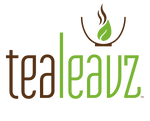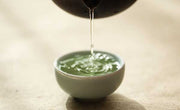What is Boba Tea vs Bubble Tea?

Boba tea drinks originated in Taiwan in the 1980s. In Taiwanese, "boba" is slang for "pearls". When people refer to “Boba” they can be referring to a pretty broad topic of chunky drinks from iced tea with tapioca pearls to fruit juice with chunks of fruit.
Prior to the discovery of this unique tea drink, tapioca balls were commonly used as toppings on desserts such as shaved ice which is popular throughout Taiwan. At the same time, Milk tea was a favorite local drink, so this combination was inevitable.
But for the Boba craze that is growing popularity in tea shops all over Asia, North America, and Europe, it is typically referring to the cold, frothy tea drinks made with tea, flavors, sweeteners, sometimes milk, and served with black tapioca pearls that settle at the base of your glass.
Boba pearls range in size from peas to marbles, and you may find some that are square-shaped. For this reason, boba is enjoyed with an oversized straw to accommodate the large pearls.
The terms Boba tea and Bubble tea are interchangeable, based on where you are standing when you say it. In the US the East coast prefers to call it Bubble Tea, while the West calls it Boba Tea.
Boba Tea Ingredients
Boba pearls are made from tapioca starch of the cassava root. This plant native to South America contains a significant amount of calcium and vitamin c, and is naturally gluten-free. Tapioca pearls are often white, but they can also be found in many colors.
The pearls are hard, and lacking much flavor in the raw form. After boiling in large vats, they are allowed to steep for hours in a caramelized brown sugar syrup until they become the black, soft, and chewy tapioca balls that make Boba tea so addictive.
Boba pearls are actually rated with a Q factor (Q or QQ), depending on how soft or bouncy. The right amount of Q has just the right amount of bounce. "Q" is also used to grade the texture of mochi, fish balls, and noodles in Taiwan. This rating is similar to the Italian "al dente" for pasta.
As its name refers to it, Boba tea begins with a tea base. For the boba connoisseur, gourmet loose leaf tea is used. Flavors and sweeteners are then added.
Types of Boba Tea
There are many variations of boba tea that are determined by the flavors that are added such as strawberry, taro, chocolate, almond, lavender, and even coffee. Some boba teas are a thin, sweet liquid while some are rich and thick.
It's called a Milk Boba Tea if the creaminess of milk, almond milk, condensed milk, or non-dairy creamers are used. Clear Boba Teas do not have any cream added.
Popping Boba vs Tapioca Boba
Boba tea can also be made with Popping Pearls that are made from a seaweed extract with fruit juice flavoring inside that "pop"s once bitten into. Popping pearls are popular over frozen yogurt as they are not as sweet as tapioca pearls.
Popping pearls come in a variety of flavors such as Mango, Strawberry, Pomegranate, and Peach. The surprise of the burst of fruit juice will keep you coming back. (Or maybe not, if you don't like surprises...)
How to Make Boba Tea
Whichever type you choose, the ingredients are added together and shaken until the drink is nice and frothy, creating bubbles on the top. A hefty scoop of chewy tapioca pearls is added to the bottom of the drink, creating a contrast to the sweetness and the texture of the drink.
Robust teas such as black tea or chai tea are the best teas to use for Boba. When you add the milk and ice cubes it will water down the flavor a bit, so start with a strong tea that will retain its flavor. A black tea blend of Assam and Ceylon such as Irish Breakfast is a good place to start.
Tapioca pearls are available in Asian supermarkets or online. Fast cooking pearls may tend to lack in texture but be prepared that the slower cooking tapioca pearls can take up to an hour to cook. Only cook up what you need, because cooked tapioca pearls will stiffen as they cool, and don't store well overnight. Remove the pearls you want with a slotted spoon and leave the unused pearls in the cooking water and you will have better luck at retaining the soft texture for a longer period of time.
You can use milk to your preference, but whole milk will create the rich flavor that makes the beverage so tasty. Experiment with heavy cream or half and half, but be prepared for a very rich cup of boba. A dairy-free boba can be made with nut milk or soy milk.
When adding sweetener to your Boba milk tea, be sure to mix it in while the tea is hot to allow the sweetener to dissolve completely. Any kind of sweetener will work to sweeten your Boba tea, such as honey, simple syrup, or granulated sugar. Use at least 2 tablespoons of honey for every 2 cups of tea, and adjust based on your preference.
Boba Tea Calories
The USDA says the average caloric content of boba tea is 120 calories, with zero protein. Depending on what you put in your Boba (whole milk, coconut milk, or non-dairy), the fat content can vary. On average an 8oz glass will have 28 grams of carbs, zero fiber, and 28 grams of sugar.
This is based on the "average" boba. If you add pudding, jellies, and syrups these counts could change drastically.
While there are very few health benefits in a glass of boba, the calories and carbs can provide a boost in energy when you need it. Just be careful with the high levels of sugar, which could lead to long-term health conditions like diabetes and obesity.
Does Boba Tea have Caffeine?
However, because boba contains tea, you are benefiting from the healthy qualities of the tea you choose. This also goes for the caffeine content of boba tea. If you choose green tea or black tea, you will also benefit from the kick of caffeine naturally present in the tea.








